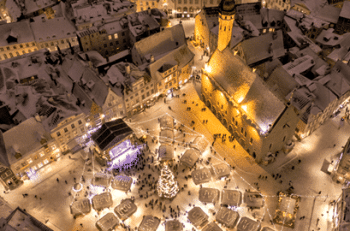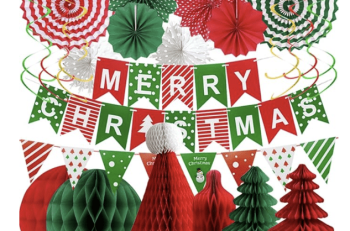This Ultimate Guide to Indoor Christmas Lights will highlight everything you need to consider before buying festive illuminations for your home or place of work.
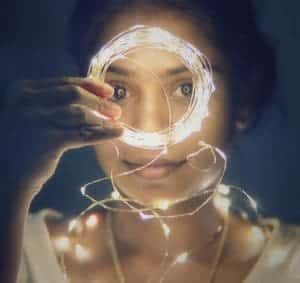 If you would like more information about Christmas lights to place outdoors, then you need to read our sister ‘Outdoor Christmas lights – What you need to know’.
If you would like more information about Christmas lights to place outdoors, then you need to read our sister ‘Outdoor Christmas lights – What you need to know’.
There’s no doubt that many people enjoy decorating with Christmas indoor lights, whether that’s to brighten up a mantelpiece, window or a room.
First, let’s focus on indoor lights and how they can add the ‘Wow’ factor to your festive home. We have advice on adding lights to blank wall spaces and being subtle in ‘busy’ parts of your home to create a colourful and bold look.
It helps too that the low cost of LED lights means that creating a striking room is within the budget of everyone
This ‘Ultimate guide’ from Christmas.co.uk will look at:
- Multicoloured Christmas lights
- Mains and battery-operated indoor lights
- Fairy lights
- LED lights
- Rope lights
- String lights
- Christmas decorations.
If you want to know more about Christmas tree lights, we have a special section towards the end of this guide to answer all of your questions. The information includes choosing the right Christmas tree lights, how to place them on a tree – and how to store them, plus much more!
Essentially, we will help you achieve an indoor lighting display to impress at Christmas.
Why buy indoor Christmas lights?
There’s no doubt that indoor Christmas lights are becoming a ‘must-have’ decoration that many of us cannot do without during the festivities.
From novelty lights, fairy lights and string lights, every aspect of placing indoor Christmas lights and what you should be looking for to create the best festive effect, is covered here.
It’s worth noting too that some of the lights that can be used for indoor decorations are also suitable for placing on Christmas trees, though lights for indoor trees tend to have more lights per metre of cable to create that ‘clustered’ look.
However, when it comes to choosing indoor Christmas lights you need to be aware of selecting the right lights for the job – there’s no point putting 2,000 cluster lights on a 3ft tree, or 20 battery-powered fairy lights on a 10ft tree! We will go through the steps you need to take to deliver the right number and design of lights to deliver the perfect festive illumination.
When should you install indoor Christmas lights?
Since there’s no official date for installing Christmas decorations, you can begin buying and installing indoor Christmas lights whenever suits you in the run-up to the festivities – growing numbers of people appear to start decorating their home in early/mid-November, while others will prepare in December.
There’s no reason either for you not to enjoy your festive lights creation all-year-round! This could be for your indoor and outdoor Christmas lights – and lots of people appear to be keeping their outdoor lights in place to enjoy on warm summer nights.
And, for many people, it’s never too soon to begin putting up Christmas decorations and lights.
Lots of people tend to choose the first day of Advent to begin their Christmas decorations and maintain the religious aspect for the festivities. Advent is the time that covers the four Sundays and weeks before Christmas – though most people will begin their advent countdown from 1 December.
When should you remove indoor Christmas lights?
While we mention that many people will be installing Christmas lights to brighten their home in the run-up to the festive period, there is a date for when they are traditionally removed.
For most people, Epiphany is when they will take down all of their Christmas decorations and tree because this date, on January 6, will mark the end of the Christmas period.
A common belief is that if you do not take down your decorations by this date, you will have bad luck – which is why some people who don’t take down their decorations will keep them in place until Christmas comes around again.
Though, if early January is too soon for you, there is another date in the religious calendar where Christmas will officially end and that’s the feast of Candlemas which takes place on February 2.
How to choose indoor Christmas lights
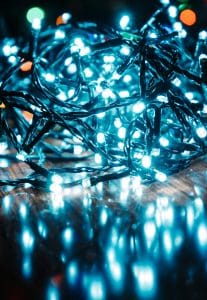 This is the time of year to make your home sparkle with Christmas lights.
This is the time of year to make your home sparkle with Christmas lights.
Whether you tend to be reserved when putting up your Christmas lights, or whether you prefer to go all out, you need to consider these issues first:
- Which type of lights do you want?
You should really consider the space that you want to put the lights up in, and the type and number of lights necessary to illuminate it effectively.
This will then help steer your decision making towards which type of light will do the best job – string lights, rope lights, lanterns or cluster lights?
- What features do the lights have?
Will the lights you choose for your indoor display have a timed flashing feature, or simply glow whenever switched on? Will they change colour or create a pattern? There’s a wide range to choose from to decide before buying on the impression you want to create.
- How will your indoor lights be powered?
Depending on where you want to illuminate, you need to decide between mains or battery power. While battery-powered lights bring the prospect of placing lights in unusual places, they tend not to be as bright as those plugged into the mains.
Alternatively, using mains-powered indoor lights means creating a more dazzling effect with more lights if there’s a power socket or if you use an extension cable.
- Choosing a style of indoor lights
When you have an idea of where you want to put lights, which type of light, and how they will be powered, means you can move onto the next step. There is a range of styles from plain lights, to coloured, to candles and novelty Christmas lights.
Don’t forget too that this is the time of year to decide whether you want to decorate just one room – or several. You might want to brighten your kitchen or hallway with lights, or simply add a flourish of lights to your living room.
Choose your indoor bulb colour
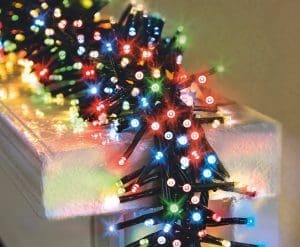 You will need to think about the colour of the Christmas lights you will be needing – either welcoming traditional lights of white or warm white – two of the most popular colours – or going for something multicoloured to be contemporary and different. LEDs bring the opportunity to have multicoloured bulbs that change colour with a variety of tones that will change on rotation.
You will need to think about the colour of the Christmas lights you will be needing – either welcoming traditional lights of white or warm white – two of the most popular colours – or going for something multicoloured to be contemporary and different. LEDs bring the opportunity to have multicoloured bulbs that change colour with a variety of tones that will change on rotation.
Choose your cable colour
The other important consideration – and not every guide will mention this – is the colour of the lead for the bulbs. For example, a dark green cable will blend perfectly into the background of a Christmas tree.
Otherwise, you should think of a clear light cable for decorating a picture or mirror, or white if you have a white banister. Copper wires tend to work well in most environments.
Other wires for the bulbs can be silver, gold, pink, blue and red.
There is a range of coloured cables to suit indoor Christmas lights so it’s always worth shopping around.
Choose your light shape
Your Christmas light shapes could be a cluster string of stars or a glowing 3D silhouette. String lights offer a range of shapes from a straight line that can be draped just about anywhere, nets that have a rectangular or square shape, or curtain-shaped lights to replicate window curtains. Plus, there are icicle indoor lights too. Manufacturers create a wide range of styles and shapes, so it is worth shopping around.
Bulb numbers and the length of Christmas light strings
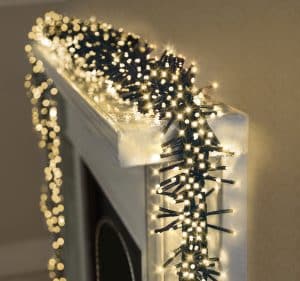 Another important issue to consider for your indoor Christmas lights is how many LEDs you want to use. For example, cluster light strings will deliver a lot of bulbs along a short stretch of cable. They usually have a gap of 2.5 cms, while a fairy light string will have wider gaps.
Another important issue to consider for your indoor Christmas lights is how many LEDs you want to use. For example, cluster light strings will deliver a lot of bulbs along a short stretch of cable. They usually have a gap of 2.5 cms, while a fairy light string will have wider gaps.
Put simply, this is important because the spaces between the bulbs determine the concentration of lighting – which in turn will determine the style of lights you are wanting and the area you want to illuminate with a single set of lights.
Essentially, it is the type of light needed for the illumination that will determine how many lights are needed and how long the light string will need to be. This also means that you may need more than one set of lights to achieve the festive look you are after. Fairy or string lights with their wider gaps may suffice, but for a brighter display choosing cluster lights with smaller gaps will offer more bulbs on the cable because they are fitted closer together.
You also need to decide whether you want mains or battery-powered lights.
TIP: If you do opt for battery power, then remember to stock up on batteries.
You could even choose mains-powered lights with a timer switch, so you only use them when you are in your home. It helps that most modern sets of lights will come with an inbuilt timer to have the lights working for eight hours, and then switch off for 16 hours. Nobody wants a large electric bill after Christmas!
Choosing the style of your indoor Christmas lights
Here at Christmas.co.uk, we are always impressed by the sheer range of indoor Christmas lights that are available. This is down to the abundance of LED lights, on top of the traditional string of lights with fewer bulbs. Remember that with non-LED creations you run the risk of the bulbs failing. And failed bulbs need replacing because the entire string will not work.
Each style of indoor Christmas lights will work for a different purpose, so you need to consider which set of indoor lights will work best for you and your home.
Christmas string and fairy lights
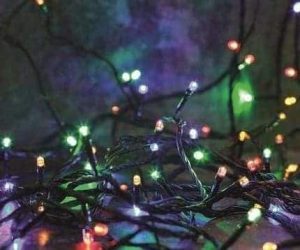 String and fairy lights differ from cluster lights (see below) since a string is a classic look with lights being strung along a length of cable. The bulbs are placed close to each other and are available in different sizes. They are more decorative and as such do not illuminate the space beneath them.
String and fairy lights differ from cluster lights (see below) since a string is a classic look with lights being strung along a length of cable. The bulbs are placed close to each other and are available in different sizes. They are more decorative and as such do not illuminate the space beneath them.
Christmas string and fairy lights with LEDs or small bulbs are good for decorating mantelpieces, bannisters, fireplaces and wreaths.
They will bring a festive glow when used correctly and for those who don’t want LEDs, string lights are available in traditional bulb formats.
Cluster Christmas lights
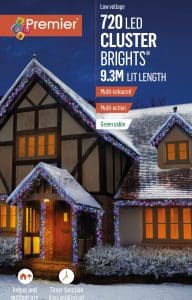 Cluster Christmas lights should not be confused with string lights.
Cluster Christmas lights should not be confused with string lights.
Cluster lights bring a full, luxurious look and since the bulbs are spaced closer together than they are for string lights, you can usually have four times as many lights on the same length of cable as string or fairly lights do. For many people, they create the perfect indoor festive display for mantelpieces, window frames and bannisters.
Think of cluster lights as a thick piece of tinsel that is covered in lights, whereas fairy or string lights are just like a piece of string dotted with lights.
And with so many individual lights, the area where they are fitted will appear bright, and very well lit.
You can buy cluster lights from hundreds of lights on a cable to 2,000 lights.
Compact cluster lights
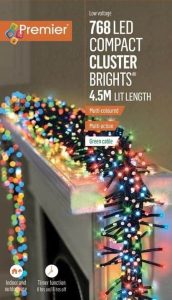 When looking at the potential for using indoor Christmas lights, there’s also the opportunity of compact cluster lights.
When looking at the potential for using indoor Christmas lights, there’s also the opportunity of compact cluster lights.
For example, you can buy cluster lights that have 720 LEDs on a 9.3m cable – while compact clusters can have 768 LEDs on a cable that is 4.5m long. For some installations, a compact cluster will deliver a better impression with more lights on a shorter cable.
Most manufacturers design their compact cluster lights to be super bright and this works well as a room feature.
Novelty indoor Christmas lights
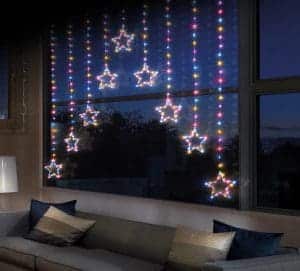 Installing novelty indoor Christmas lights during the festive period will bring a smile to many faces.
Installing novelty indoor Christmas lights during the festive period will bring a smile to many faces.
There are multicoloured lights, bright lights, big lights and character lights to choose from. We love the classic wooden signs that light up, as well as:
- Lights in the shape of colour-changing snow dogs
- Wooden birdhouse LED lights
- Flickering candles with remote control
- Flashing silver or gold fabric bows
- Even a diorama Christmas nativity scene!
Manufacturers and retailers really have used their imagination in recent years as growing numbers of us opt to have something unusual for their indoor Christmas tree light display.
Rope lights to use indoors
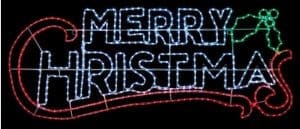 It’s also worth considering rope lights as you can cut them down to suitable lengths – or buy them as ready-made lights, like this one pictured.
It’s also worth considering rope lights as you can cut them down to suitable lengths – or buy them as ready-made lights, like this one pictured.
Rope lights can be large so you need to carefully consider where they should be placed for optimum use – get this wrong and your indoor display will be over-powering. Again, they are available in single colours or in multicoloured ropes that change colour.
For some rooms, having the indoor rope light as the main source of illumination, for example in a conservatory, will be a fetching and stylish creation.
Considerations for LED lights
When it comes to LED indoor Christmas lights, they are available as flickering candles, candle shapes, shaft bulbs, flame tip candle bulbs and golf balls – among others.
There’s also a design issue here for the lights you buy.
And that’s the fact that most LED lights will sit on the cable in a housing called a whisker.
However, the length of the whisker will vary based on the style of lights. For higher concentration lights, such as clusters, the whiskers tend to be longer, or the bulbs would crowd each other out.
As mentioned earlier in this Ultimate Guide to Indoor Christmas Lights, LED offerings are becoming increasingly popular, but what are the advantages of having LED Christmas lights?
- Compared to traditional lightbulbs, there’s a 90% energy-saving
- Compared to filament bulbs, there’s a 60% energy-saving
- LED lights offer a service life that is 50 times longer than incandescent lightbulbs
- LED lights can last up to 50,000 hours
- When switched on, they deliver 100% of light output
- LED Christmas lights are environmentally friendly because there’s no mercury content
- LED lights are modern, space-saving flat designs.
It’s for this reason that we focus on the benefits of LED lights as they are becoming more popular than traditional lights.
Indoor Christmas lights: Mains or battery power?
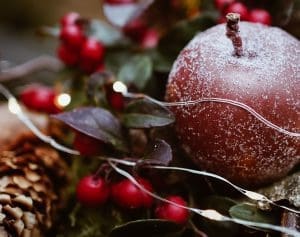 While there’s no doubt that indoor Christmas lights can bring lots of fun and style, you need to give some thought as to whether they will be powered by the mains or by battery.
While there’s no doubt that indoor Christmas lights can bring lots of fun and style, you need to give some thought as to whether they will be powered by the mains or by battery.
It will help you to decide before investing in your indoor lights because there are pros and cons for each of these.
Battery operated Christmas lights pros:
- They are energy efficient and cheap to run
- Fewer battery-powered lights can be just as effective as lots of cluster lights
- You can place the lights wherever you want
- They are most suitable for using indoors
- The battery packs are available in different colours to suit your theme – or you can paint or hide them!
- They have a low voltage which makes them safe to use.
The cons for using battery-operated Christmas lights include:
- Depending on the batteries, you may only get 30 days – or less if you have them on for long periods – of use
- Some battery packs can be chunky and hard to hide
- Battery-powered Christmas lights tend not to be as bright as mains operated lights
- They tend to have fewer bulbs than mains-powered LED lights
The pros for using mains operated Christmas lights include:
- They have a much longer lifespan – up to 10 years
- Some of these indoor lights can be used outdoors (though you’ll need a suitable outdoor socket or run them from an indoor socket, and the lights will need to be rated as IP65 as they will need to be waterproof)
- They are much brighter than battery-powered lights
- They usually have more bulbs
- There is a wider range of styles
- They offer more space between bulbs
- There’s more choice in bulb colours.
The cons for using mains operated Christmas lights include:
- You are restricted as to where you can put the lights
- You will need a plug socket close by
- They may not have a long cable
- You may not be able to hide the cable
- Choose the bulbs carefully because they cost more to run – LED lights are more energy efficient
- It is more difficult to decorate other areas such as the staircase and fireplace with mains operated lights.
These are just some of the things to think about when it comes to deciding whether you want battery-powered, or mains powered indoor Christmas lights for your home.
Think carefully about the pros and cons and invest in the lights that will deliver the most impressive display for meeting your indoor lighting needs. This is just part of the planning and preparation of buying indoor Christmas lights.
Where to place your indoor Christmas lights
Nicole Parsons explains how to hang curtain/string lights on a wall – without damaging the wall! Tips include not using strong sticky tape and she explains how to measure the string of lights for hanging – and bunching the lights up before work begins.
There are some obvious places for hanging your indoor Christmas lights and some more unusual options.
Using Christmas lights effectively will help create an ambience that is welcoming and warm.
And this is the perfect time of year for creating an air of magic and wonder, and with lights you don’t need to spend a fortune achieving this.
Remember that the length of the lights is important. Usually, a string of lights will help create a festive atmosphere in any room. You can place indoor Christmas lights on:
- Banisters
- Windows
- Mantelpiece
- Ceilings
- Along the skirting boards.
For the best effect, you need to choose the right Christmas lights for the job. For example, two metres of battery-powered copper wire firefly fairy lights with 20 warm white LEDs will look better on a mantlepiece than on a small tree – and look ridiculous on a 10ft tree.
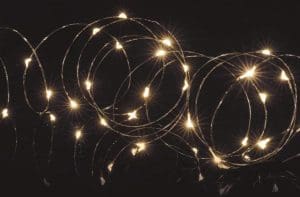 Cluster LED lights will also work well on mantlepieces and bannisters – that’s because there will be more lights to help create the dramatic effect you are looking for.
Cluster LED lights will also work well on mantlepieces and bannisters – that’s because there will be more lights to help create the dramatic effect you are looking for.
For example, you could double up on the two metres of the copper wire firefly lights mentioned previously and use two plug-in sets to decorate a large glass-fronted cabinet or wooden shelving. This would bring 400 warm white LEDs into the room to create an unusual and friendly feature.
You can even buy well-designed items such as a firefly Christmas tree decoration to hang on a wall. The warm, battery-powered twinkling LED lights will create a feature to impress.
You can also add indoor Christmas lights to your bedroom walls and ceiling, as well as in children’s bedrooms.
If you are considering placing Christmas lights in your bedroom, then think about:
- Pinning them to the wall above your headboard
- Draping them from the end of the bed
 Placing them underneath furniture – this works well on wooden floors!
Placing them underneath furniture – this works well on wooden floors!- Creating a Christmas tree using a branch without leaves but just add the string lights and baubles
- Adding lights around your bedroom window
- Hanging them from the ceiling, for example across from corner to corner
- Opt for using different shapes such as stars to hang from your headboard
- Use lights hanging from a canopy so they twinkle
- If you add Christmas cards to string to pin on a wall, then add string lights as well for a really stand-out look.
When it comes to using indoor Christmas lights to decorate your home, there are no limits as to where you can place them. Battery-powered lights are best if you are feeling inventive because you won’t be restricted by the location of a plug socket.
How to store your Christmas indoor and tree lights
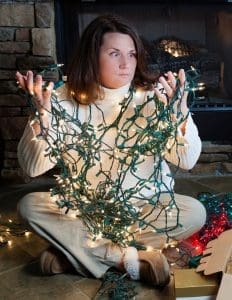
Young woman sitting next to Christmas tree holding entangled string of lights
It happens every year, whenever we reach for the Christmas lights, we find they are tangled but how do you store your Christmas lights properly?
It’s important that you pack up your Christmas lights correctly every year and there’s an easy way to do it:
- Buy Christmas light storage wheels and wrap the lights around them
- OUR TOP TIP: Simply use a coat hanger so you can easily wrap and then unwrap your lights without getting them knotted.
It’s also possible to buy specialist light storage bags to help protect and organise your string lights for next Christmas.
Indoor Christmas light safety – the dos and don’ts
No article about installing indoor Christmas lights, and Christmas tree lights, should not mention the issue of light safety.
It’s an issue that most of us tend not to think about as we are enjoying ourselves putting up Christmas lights – but it is an important aspect to consider.
We all tend to think that nothing will go wrong, and this handy guide will ensure you think about the important aspects of installing indoor Christmas lights.
Our indoor Christmas lights safety guide
- When buying lights, check for a safety mark such as the BS kitemark
- Carefully read the instructions
- Check the lights have the right rating of fuse installed
- Opt for energy-saving low voltage LEDs as these emit less heat and are cheaper to run
- Always replace a failed bulb immediately to avoid the potential of overheating
- Replace a failed bulb with the same rating and type as the original
- When going to bed, remember to switch your lights off
- Use a surge-proof plug adapter or extension
- Opt for battery-operated lights if there is no plug socket nearby
- It’s worth checking the wires regularly to see if they are overheating
- If your real Christmas tree comes with a water reservoir, ensure the wires never enter the water.
There are also some indoor Christmas lights safety issues that you must never do, including:
- Never use indoor lights that are damaged
- Never replace a bulb when the cable is still plugged in
- Never plug an adapter into another adapter because you risk overloading the socket
- Never use lights designed for indoor use outdoors
- Never run indoor light cables across where people, particularly children and pets, walk as this creates a trip hazard – and someone will bring down your beautiful display!
- Do not place your indoor lights next to flammable materials or decorations.
Christmas tree lights – everything you need to know
Just about every home in the UK during the festivities will feature a Christmas tree festooned with lights since they make a room look bright and festive.
Christmas tree lights add warmth when friends and family gather and there are a number of choices when it comes to Christmas trees. They include:
- Artificial Christmas trees: A great choice for families, they can last for years, and you get to choose the type and style of Christmas tree lights to suit your home
- Real Christmas trees: While you only have a real Christmas tree for the festivities the branches and trunk lend themselves to some impressive Christmas tree light opportunities
- A pre-lit Christmas tree: A pre-lit Christmas tree is easy and quick to assemble with the lights already added
- Fibre optic Christmas trees: Similar to pre-lit Christmas trees, fibre optic alternatives offer a twinkling range of colours from light to dark. Most modern fibre optic Christmas trees no longer use a bulb or a motor in the base so the fibre optics use less energy and will work for longer – they tend to be ‘lit whiskers’ today
- LED Christmas trees: A modern take on Christmas trees will see a tree without branch coverage and instead LED lights are wrapped around the trunk or placed on the branches. This approach really does create a standout feature.
The bottom line when choosing your indoor lights is:
- How many LED bulbs are fitted to the cable?
- Is the cable long enough for the tree/other location?
- Do you need an extension for the lights if they aren’t close to a plug socket?
How many lights do I need for a Christmas tree?
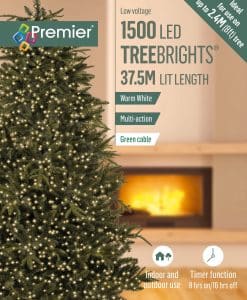 Every Christmas tree needs lights to make it look festive, but how many lights will you need for the impact you desire?
Every Christmas tree needs lights to make it look festive, but how many lights will you need for the impact you desire?
Getting the number of lights right can be tricky, whether you have a real or an artificial Christmas tree.
It’s also worth bearing this in mind as the price of indoor Christmas tree lights fall in price, most of us are opting to use more lights. This means the potential for delivering a dazzling light display on the tree and in your room is much easier. Put simply, the light clusters available for indoor Christmas trees means there are shorter distances between the lights on the cable so manufacturers can get more LED lights onto a cable.
There is no fixed rule for how many lights you need but for a 6ft tree, you will need between 300-400 lights for a low-density appearance, 600-700 for a medium density and up to 1,000 lights for high density. It should be noted that the trend is for more lights so 1,000 lights are very popular.
This means that for a taller tree the trend now is to use many more lights for a full, impressive look. So, a 7ft tree could have 1,500 LED lights, while a 12ft tree would be needing at least 3,000 lights!
Again, a lot depends on personal preference when it comes to choosing the number of lights, but the modern style is to create a tree with a dense, well-illuminated appearance.
We mentioned earlier that there is a huge range of LED Christmas indoor lights currently available – and there is a similarly vast range for Christmas tree lights too.
These range from traditional fairy lights with larger spaces between the bulbs on the cable, to cluster designs with shorter distances to create a brighter, fuller appearance. When it comes to choosing indoor Christmas tree lights, manufacturers will promote cluster lights as these have more LEDs on them, per length of cable.
Again, these lights are available in multi-coloured offerings along with white and warm white. They also come with either a clear cable or a green cable.
You will need to think about the style of lights as this will affect the number of bulbs that you need and have an impact on the look you are trying to achieve.
You will also need to consider:
- The length of the lead from the plug to the first LED bulb – this should be at least 5 metres
- If using a cable extension, then buy one that has a longer length than you think you need (see below)
- Invest in a string of lights that have been designed specifically to deliver an even appearance
- Opt for a cluster light string with a multifunction setting – preferably eight speeds
- Opt for lights that have been designed specifically for use on Christmas trees.
The big attraction for cluster lights when lighting a Christmas tree is that you will get four times as many lights on your tree as you would with a traditional string of fairy lights.
While this should not affect the number of lights that you need, be aware that brighter lights can deliver a harsh experience and you may need fewer of these.
If you want a copper glow or a warm white look for your tree, then cluster lights will deliver a full appearance to help complement these subtle colours.
Length of lead needed for Christmas tree lights
Imagine your surprise after adding a long length of Christmas tree lights to your tree to find that your cable is not long enough to reach the socket.
It’s a good idea to measure beforehand how long the length of cable needs to be from the plug to the first bulb because this will dictate where you can place your Christmas tree in a given room.
So, you should either buy Christmas tree lights that have a long enough lead to meet your needs or invest in a quality extension – and this extension should be longer than you think you need, especially if you are planning to hide it under a rug, for example.
Christmas tree lights – bulbs needed
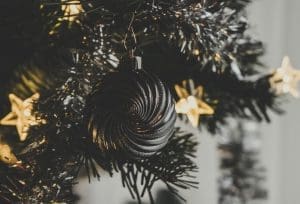 For a lot of homes, there’s the annual disappointment of unravelling the Christmas tree light cable of old fashioned, incandescent bulbs to find that some of them do not work.
For a lot of homes, there’s the annual disappointment of unravelling the Christmas tree light cable of old fashioned, incandescent bulbs to find that some of them do not work.
This is usually why LEDs are increasingly popular because they have a longer life.
If you do need a replacement traditional bulb, there are two options:
- Bulbs with a screw base – usually E10 bulbs
- Bulbs with a push-in socket.
If you need a replacement push-in socket bulb then you need to be aware of the voltage – which is registered in volts – and its power consumption, which is in watts.
The new bulb must match these exactly for it to work.
TIP: Always ensure that your Christmas lights are unplugged from the mains before replacing any bulb.
Don’t forget that Christmas tree lights with built-in LEDs are becoming popular and these will bring many years of service. It’s unlikely you will need to replace any LED lights every Christmas.
How to place lights on Christmas trees
Here, Hayes Garden World show how LED lights should be added to an artificial Christmas tree – including switching the lights on beforehand so you can see where they are being placed!
Having everyone get involved with trimming the Christmas tree is an enjoyable tradition for many families. For others, this can be a tedious and frustrating undertaking.
So, the big question is: Do you hang your Christmas tree lights vertically or horizontally?
You can hang your tree lights by going from the bottom to the top, or from the top to the bottom.
Essentially, there is no right answer and if you have a way of adding lights to your Christmas tree that works for you, then there’s no reason to change.
TOP TIP: Whichever method you choose, remember that the lights will need to be plugged in if they are mains operated, so there’s a lot to recommend starting at the bottom with whichever method you choose.
However, the most widely used technique for adding Christmas tree lights is horizontally, ie from left to right so you start at the bottom (or top) and wind your way from one to side to the other.
If you have never placed lights on a tree at Christmas, you will need to:
- Before you start, plug in your lights to ensure the bulbs or the LED lights are working
- Choose whether to start at the bottom or the top of the tree and then wrap your lights under and over the tree’s branches
- Don’t forget to add some lights closer to the trunk to help create depth and a more organic look.
If you want to know how to hang your Christmas tree lights vertically, you will need to:
- Before your start, plug in the lights to ensure the bulbs or the LED lights are working
- Start at the bottom or the top of your tree
- Lay the Christmas lights vertically
- When you reach the bottom or top, you then bring your lights back in the opposite direction until there’s a sideways ‘S’ pattern around the Christmas tree – depending on how many lights you have and how long the cable is.
TIP: With vertical hanging, hang your shinier ornaments close to the middle of the tree to reflect the tree’s lights to create depth.
The essential safety checklist for Christmas tree and indoor lights
In the Christmas.co.uk Ultimate Guide to Christmas Indoor Lights, we have discussed every aspect of buying and using lights for Christmas.
Here’s our essential safety checklist of the highlights covered in the article:
- Consider switching to LED lights for lower bills and improved safety
- Do not buy second-hand Christmas indoor lights – buy from reputable suppliers
- Check your indoor lights work before wrapping them around the Christmas tree or fixing them to a wall
- Inspect the cable and bulbs for damage
- Replace unsafe bulbs and dispose of them safely
- Do not run indoor cables under carpets – that’s a trip hazard and potential fire risk
- Keep your Christmas lights away from flammable objects – even if the bulb is low wattage
- Always follow the instructions that come with your indoor Christmas lights
- Do not leave your lights on all day long
- Do not allow children to play with your indoor lights
- Remember to store your Christmas indoor lights carefully so they can be reused next year.
Finally, when to comes to buying and using indoor Christmas lights, and Christmas tree lights, you need to consider:
- Where you are placing the lights
- The type of lights you need
- Ensure there are enough lights to deliver the effect
- Know which power source will suit their location best
- Buy safe lights that meet British safety standards
- And consider whether you want to retain your festive room illuminations all-year-round!

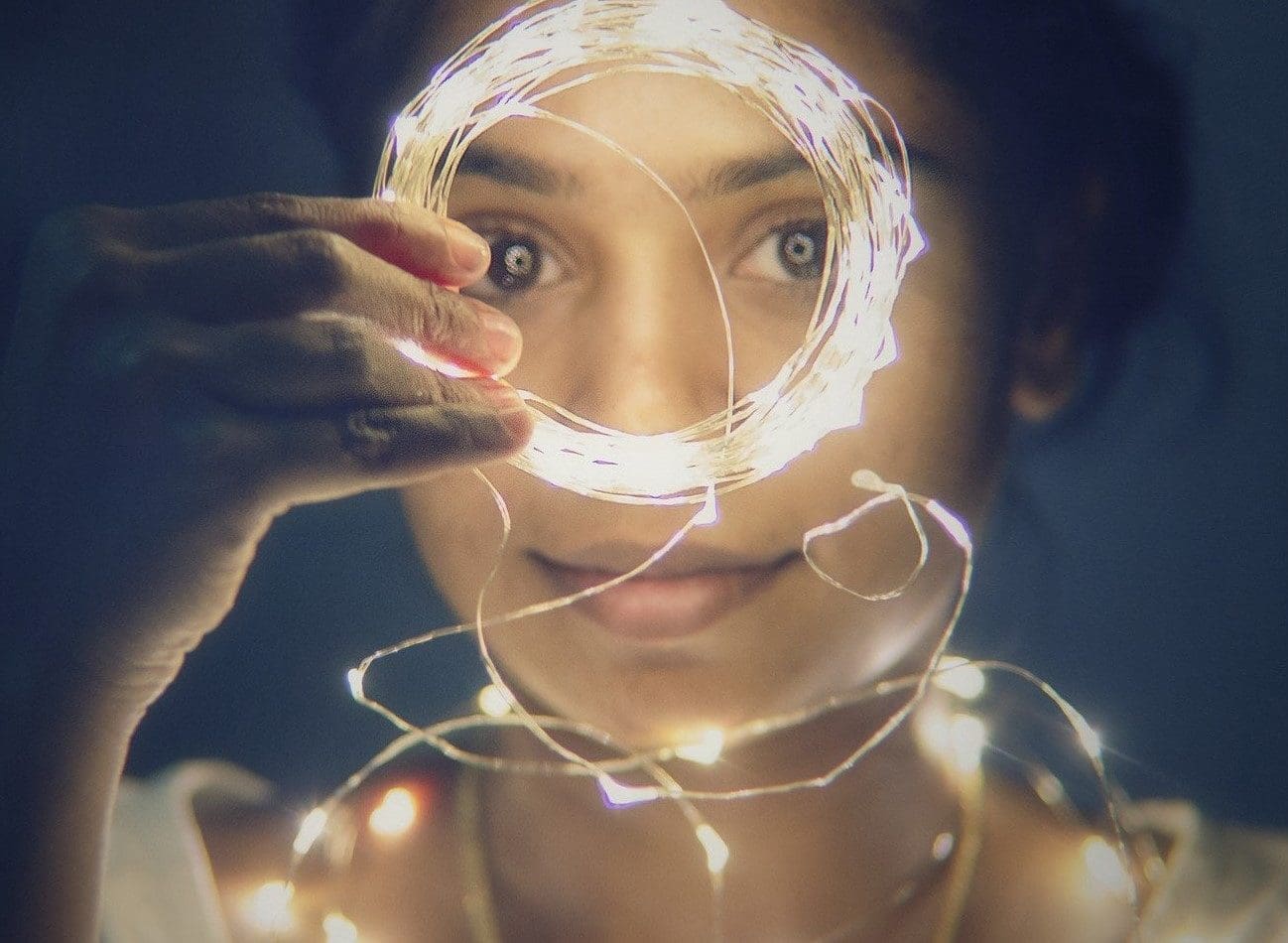
 Placing them underneath furniture – this works well on wooden floors!
Placing them underneath furniture – this works well on wooden floors!